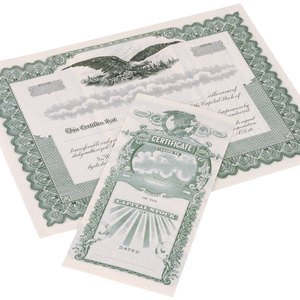
Discovering some old stock certificates in your family's financial papers or inheriting stock certificates can be exciting because there is always the possibility that the stocks are valuable. However, before you can redeem the old stock certificates, you must determine whether the stocks have any monetary value. This is accomplished by finding out whether the company that issued the stocks is still an active business concern or if it was bought and absorbed by another company.
Review the information on the stock certificate for information that can identify the company that issued the stock. For example, record the name of the company listed on the stock certificate and the state where the company issued the stock.
Check the text on the stock certificate for the "CUSIP" number. It is a unique number that a broker can use to identify the company that issued the stock. This number is especially useful if the company has been acquired or changed its business name. The number is listed next to "CUSIP."
Go to a financial website that has listings of companies that issue stocks. Dun & Bradsheet, Yahoo! Finance and Wall Street Journal are examples. Enter the name of the company that issued the stock certificate in the website's "Company Search" or "Business Search" box. If the company is active, it will appear on the Results page. If you cannot find the company, contact a stockbroker and give him the CUSIP number. The broker will be able to track down the company or the current company that is responsible for the stock. Alternatively, you can contact the state agency that manages corporations in the issuing stock company's state to determine the current status of the company and your stock's value.
Open an investment account once you determine that the stock certificates have monetary value, then sign the back of each stock certificate in the allowed section.
Mail the certificate to a stockbroker via certified mail with the appropriate insurance. The broker will notify you when he receives the stock certificates. Place a sell order for the certificates with the broker, then wait for the broker to credit your account after he sells the stocks. The amount of money you receive depends on the stock's current market value minus the broker's fees and any transaction fees.
References
Writer Bio
An avid technology enthusiast, Steve Gregory has been writing professionally since 2002. With more than 10 years of experience as a network administrator, Gregory holds an Information Management certificate from the University of Maryland and is pursuing MCSE certification. His work has appeared in numerous online publications, including Chron and GlobalPost.

